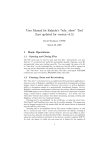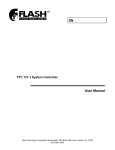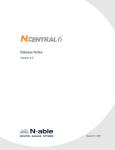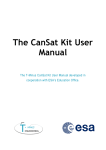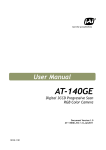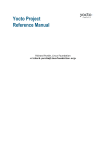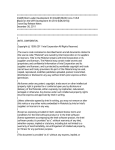Download Software Development Kit for the System Visible Event Nexus
Transcript
Software Development Kit for the System
Visible Event Nexus Technology (SVEN)
User Guide
Copyright © 2013 Intel Corporation
All Rights Reserved
Document Number: 328506-001US
Revision: 1.0
World Wide Web: http://www.intel.com
Software Development Kit for the System Visible Event Nexus Technology (SVEN)
Disclaimer and Legal Information
INFORMATION IN THIS DOCUMENT IS PROVIDED IN CONNECTION
WITH INTEL PRODUCTS. NO LICENSE, EXPRESS OR IMPLIED, BY
ESTOPPEL OR OTHERWISE, TO ANY INTELLECTUAL PROPERTY RIGHTS
IS GRANTED BY THIS DOCUMENT. EXCEPT AS PROVIDED IN INTEL'S
TERMS AND CONDITIONS OF SALE FOR SUCH PRODUCTS, INTEL
ASSUMES NO LIABILITY WHATSOEVER AND INTEL DISCLAIMS ANY
EXPRESS OR IMPLIED WARRANTY, RELATING TO SALE AND/OR USE
OF INTEL PRODUCTS INCLUDING LIABILITY OR WARRANTIES
RELATING TO FITNESS FOR A PARTICULAR PURPOSE,
MERCHANTABILITY, OR INFRINGEMENT OF ANY PATENT, COPYRIGHT
OR OTHER INTELLECTUAL PROPERTY RIGHT.
A "Mission Critical Application" is any application in which failure of the
Intel Product could result, directly or indirectly, in personal injury or
death. SHOULD YOU PURCHASE OR USE INTEL'S PRODUCTS FOR ANY
SUCH MISSION CRITICAL APPLICATION, YOU SHALL INDEMNIFY AND
HOLD INTEL AND ITS SUBSIDIARIES, SUBCONTRACTORS AND
AFFILIATES, AND THE DIRECTORS, OFFICERS, AND EMPLOYEES OF
EACH, HARMLESS AGAINST ALL CLAIMS COSTS, DAMAGES, AND
EXPENSES AND REASONABLE ATTORNEYS' FEES ARISING OUT OF,
DIRECTLY OR INDIRECTLY, ANY CLAIM OF PRODUCT LIABILITY,
PERSONAL INJURY, OR DEATH ARISING IN ANY WAY OUT OF SUCH
MISSION CRITICAL APPLICATION, WHETHER OR NOT INTEL OR ITS
SUBCONTRACTOR WAS NEGLIGENT IN THE DESIGN, MANUFACTURE,
OR WARNING OF THE INTEL PRODUCT OR ANY OF ITS PARTS.
Intel may make changes to specifications and product descriptions at
any time, without notice. Designers must not rely on the absence or
characteristics of any features or instructions marked "reserved" or
"undefined". Intel reserves these for future definition and shall have
no responsibility whatsoever for conflicts or incompatibilities arising
from future changes to them. The information here is subject to
change without notice. Do not finalize a design with this information.
The products described in this document may contain design defects
or errors known as errata which may cause the product to deviate
from published specifications. Current characterized errata are
available on request.
Contact your local Intel sales office or your distributor to obtain the
latest specifications and before placing your product order.
2
About this Document
Copies of documents which have an order number and are referenced
in this document, or other Intel literature, may be obtained by calling
1-800-548-4725, or go to: http://www.intel.com/design/literature.htm
Intel processor numbers are not a measure of performance. Processor
numbers differentiate features within each processor family, not
across different processor families: Go to:
Learn About Intel® Processor Numbers
(http://www.intel.com/products/processor_number).
Intel and Atom are trademarks of Intel Corporation in the U.S. and/or
other countries.
* Other names and brands may be claimed as the property of others.
Copyright
User Guide
© 2001-2013,
Intel Corporation. All rights reserved.
3
Software Development Kit for the System Visible Event Nexus Technology (SVEN)
Contents
1
2
3
About this Document .................................................................................................. 7
1.1
Intended Audience .......................................................................................... 7
1.2
Conventions and Symbols ............................................................................ 7
Introduction .................................................................................................................... 9
2.1
System Visible Event Nexus Technology (SVEN) ................................ 9
2.2
SVEN Debug Infrastructure ....................................................................... 10
Installing the SVEN SDK .......................................................................................... 11
3.1
Prerequisites .................................................................................................... 11
3.2
Installation ....................................................................................................... 11
4
Building the SVEN SDK ............................................................................................ 12
5
Installing the SVEN SDK File On the Local System....................................... 13
6
Testing the SVEN SDK .............................................................................................. 14
7
Uninstalling the SVEN SDK ..................................................................................... 17
8
Adapting the SVEN SDK........................................................................................... 18
8.1
Create Your Own BSP .................................................................................. 18
8.2
Defining SVEN Time Stamps ..................................................................... 19
8.3
Defining SVEN Modules ............................................................................... 19
8.4
Defining API Events ...................................................................................... 20
9
Instrumenting User Mode Software .................................................................... 22
10
Using the csven Debug Console ........................................................................... 23
10.1 Quickstart: Capturing SVEN events into a Data File ...................... 23
10.2 Loading Events From a File........................................................................ 24
10.3 Event filtering .................................................................................................. 24
10.3.1 HOT filtering ..................................................................................... 24
10.3.2 Display filtering ............................................................................... 25
10.4 Offline Viewing of Events from a Binary Event File .......................... 27
10.5 Handling SVEN Time Stamps .................................................................... 28
4
About this Document
11
Command Reference ................................................................................................. 29
11.1 quit ...................................................................................................................... 29
11.2 help ..................................................................................................................... 29
11.3 sleep ................................................................................................................... 29
11.4 pause .................................................................................................................. 29
11.5 run ....................................................................................................................... 29
11.6 monitor .............................................................................................................. 30
11.7 hdr ....................................................................................................................... 30
11.8 dump .................................................................................................................. 30
11.9 hexdump ........................................................................................................... 30
11.10 search................................................................................................................. 30
11.11 lookup ................................................................................................................ 30
11.12 modules ............................................................................................................. 30
11.13 logwrite .............................................................................................................. 31
11.14 source................................................................................................................. 31
11.15 thread ................................................................................................................. 31
11.16 decode................................................................................................................ 31
11.17 peek .................................................................................................................... 31
11.18 poke .................................................................................................................... 31
11.19 hot ....................................................................................................................... 31
11.20 trigger ................................................................................................................ 32
11.21 triggerdelay...................................................................................................... 32
11.22 triggerwait ........................................................................................................ 32
11.23 filter..................................................................................................................... 32
11.24 save..................................................................................................................... 32
11.25 load ..................................................................................................................... 32
11.26 metasave .......................................................................................................... 32
11.27 metaload ........................................................................................................... 33
11.28 metashow ......................................................................................................... 33
11.29 metareset ......................................................................................................... 33
11.30 time ..................................................................................................................... 33
11.31 overhead ........................................................................................................... 33
11.32 stream ................................................................................................................ 33
11.33 timestamp ........................................................................................................ 33
11.34 systime .............................................................................................................. 34
User Guide
5
Software Development Kit for the System Visible Event Nexus Technology (SVEN)
11.35 echo .................................................................................................................... 34
12
Understanding the SVEN SDK Folder Structure ............................................. 35
§
6
About this Document
1
About this Document
This document describes the preview of the Software Development Kit
for the System Visible Event Nexus technology (SVEN SDK). The SVEN
SDK contains the source code for the event tracing infrastructure
using the System Visible Event Nexus technology (SVEN) and related
tools. You can use it to adapt the SVEN event tracing infrastructure to
a Linux* platform. It also provides the necessary C/C++ include files
and libraries for adding SVEN event instrumentation calls to kernel
mode drivers and user space applications.
1.1
Intended Audience
The SVEN SDK is intended for software and validation engineers that
plan to add SVEN software instrumented trace calls to their driver and
application code. It provides the platform runtime infrastructure for
collecting events and the development environment (headers and
libraries) for instrumenting software modules.
1.2
Conventions and Symbols
The following conventions are used in this document.
Table 1 Conventions and Symbols used in this Document
This type style Indicates an element of syntax, reserved word, keyword, filename,
computer output, or part of a program example. The text appears in
lowercase unless uppercase is significant.
User Guide
This type style
Indicates the exact characters you type as input. Also used to highlight
the elements of a graphical user interface such as buttons and menu
names.
This type style
Indicates a placeholder for an identifier, an expression, a string, a
symbol, or a value. Substitute one of these items for the placeholder.
[ items ]
Indicates that the items enclosed in brackets are optional.
7
Software Development Kit for the System Visible Event Nexus Technology (SVEN)
{ item | item }
Indicates to select only one of the items listed between braces. A vertical
bar ( | ) separates the items.
... (ellipses)
Indicates that you can repeat the preceding item.
§
8
Introduction
2
Introduction
2.1
System Visible Event Nexus Technology
(SVEN)
SVEN is a software technology (and API) that collects real-time, fullsystem visible software “event traces.” SVEN is currently built into
Intel media/display drivers and is the primary debug tool for the
Intel® Media SoC debug, performance measurement and regression.
SVEN is simply a list of software events with high resolution
timestamps. The SVEN API provides developers a method of
transmitting events from any operating system context and firmware.
User Guide
9
Software Development Kit for the System Visible Event Nexus Technology (SVEN)
2.2
SVEN Debug Infrastructure
The SVEN debug infrastructure consists of a small and fast “event
transmit” (SVEN-TX) library and a verbose capture and analysis
(SVEN-RX) capability for viewing and post processing. The TX library
also contains debug hooks for the Intel system debugger. It enables
the debugger to utilize SVEN instrumentation for advanced break
conditions.
10
Installing the SVEN SDK
3
Installing the SVEN SDK
3.1
Prerequisites
• Build the SVEN SDK on the same platform where you intend to run
it. Installation using a cross-build environment like the Yocto Linux*
pokey environment is not supported by this release.
• The SVEN SDK supports 32-bit and 64-bit Linux* systems using
kernel 2.6.37 or higher. Building the SDK requires the GNU
development tools for C/C++, GNU make and the kernel
development environment for modules.
• The following command shows how to install the required
components for a MeeGo 1.2 IVI release:
$ sudo zypper install kernel-adaptation-intel-automotive kerneladaptation-intel-automotive-devel make gcc gcc-c++
3.2
Installation
The SVEN SDK is provided in full source code. Follow the steps below
to build and install it on your local system:
1. Go into the sdk folder of your local SVEN SDK copy.
2. Run make from inside the sdk folder.
The SVEN SDK is built (see also Building the SDK).
3. Run make install with root privileges.
The SVEN kernel modules, header files, tools and libraries are built
(see also Building the SDK).
4. Verify the installation using the included sventest.ko driver and
the csven debug console utility (see also Testing the SVEN SDK).
Optional: Adapt the SVEN SDK to your needs and repeat the above
build and install steps (see also Adapting the SVEN SDK).
User Guide
11
Software Development Kit for the System Visible Event Nexus Technology (SVEN)
4
Building the SVEN SDK
The SVEN SDK comes with a simple GNU make based build system. It
allows building the SDK without changes and makes it easy to replace
it with a custom build system used for the target platform.
The build system understands the following environment variables to
customize the build:
Variable
Meaning
Default value
SVEN_BSP
KBUILDDIR
Directory name of the
SVEN board support
package (BSP) inside
the bsp folder that gets
used during build
example
Location of kernel
module build
environment
/lib/modules/`uname –r`/modules
The example BSP that ships with the
SDK.
The module build environment for the
currently running kernel.
Use the following commands to build the SVEN SDK with default
settings, which mean using the example SVEN SDK BSP and the
currently installed kernel.
$ make clean
$ make
12
Installing the SVEN SDK File On the Local System
5
Installing the SVEN SDK File On the
Local System
After building the Sven SDK successfully, run the following command
to install the Sven SDK file on the local system. This step needs root
rights as it copies the tools, kernel modules, libraries and header files
into the system directories like /usr/include, /usr/lib and
/usr/bin.
$ sudo -E make install
User Guide
13
Software Development Kit for the System Visible Event Nexus Technology (SVEN)
6
Testing the SVEN SDK
This chapter assumes that the SDK was successfully build and
installed.
Enter the following commands to test the SVEN SDK integration on
your platform:
1. Load the sventest.ko driver that issues periodic SVEN events to the
SVEN event nexus. This step requires root rights as it loads kernel
modules into the running kernel.
$ sudo modprobe sventest
2. Verify that both the sven and sventest kernel modules are loaded
into the kernel using the following command:
$ lsmod | grep sven
sventest
sven
1433
25727
0
1 sventest
3. Check your system event log if the modprobe command above
produced an error or if one of the two SVEN modules is not listed
by lsmod. The event log is either shown on the console window or
can be investigated with the following command:
$ sudo tail
/var/log/messages
4. Run the SVEN console application csven:
$ csven
The console displays the output such as:
SVEN Interactive: Built Mar 22 2012
Copyright 2006-2012 Intel Corporation All Rights Reserved
type help for a list of commands or quit
(ev): 32 (long):4 (int):4 (short):2 (char):1
SVEN-Header: ver:
'SVE2' disab: 00000000 debugfl:
00000000
: hdr_pa:35550000 hdr_sz:00001000
: buf_pa:01c00000 buf_sz:00100000
cb_count:00000001
14
Testing the SVEN SDK
SVEN-CBuf-0: cb_pa: 01c00000 cb_siz:00100000 cb_pos:
00000072 cb_id: 00000000
sven>
5. Enter the command “timestamp calc” to detect and validate the
time stamp clock input from the BSP:
sven> timestamp calc
Calculating SVEN timestamp frequency for 30
seconds.......... done
Average sven clock ticks per second: 71211
time: 1 wall clock: 01000202 sven: 00069925
time: 2 wall clock: 02000439 sven: 00136149
time: 3 wall clock: 03000594 sven: 00207586
…
time: 28 wall clock: 28007436 sven: 01998913
time: 29 wall clock: 29007660 sven: 02065132
delta -1286
delta -4987
delta +226
delta +31454
delta -499
Standard deviation of sven clock for 1 second durations :
11179 (156981.123 us)
WARNING: Clock source for sven is unstable !!!
SVEN Timestamp Frequency (kHz): 71 0x00000047
The command prints the red marked warning above if the
timestamp clock produces unreliable results. Try adding the Linux*
kernel boot option “idle=halt” if the CPU time stamp counter is
used for calculation SVEN time stamps. This option disables Cx
sleep mode utilization, which causes the TSC to stop counting on
various CPU families.
Verify that the frequency shown on the last line matches the value
specified in the BSP.
The default wall clock timer frequency is 1000 kHz.
The frequency used by the TSC clock input is
MAX_CPU_FREQUENCY / 1024, for example 1269 kHz on a 1.3 GHz
CPU.
6. Enter the command “monitor” into the sven console. The console
will display event sequences from the SVENTEST module.
sven> monitor
svenlog_thread_created
dt:376716.584 mt:376716.584 M:00 U:00 T:debug_str S:log
"SVEN:RBD_ABSENT"
User Guide
15
Software Development Kit for the System Visible Event Nexus Technology (SVEN)
dt: 388.965 mt:377105.549 API: call sventest_timer_tick(
pointer: 0x00000000.f84583b8 );
dt:
0.003 mt:
0.003 M:SVENTEST
U:00 T:debug_str
S:FuncEnter
"sventest_timer_tick"
dt:
0.002 mt:
0.002 M:SVENTEST
U:00 T:module_event
SLOW_TICK count: 83 jiffies: 03324252
dt:
0.004 mt:
0.004 M:SVENTEST
U:00 T:debug_str
S:FuncExit
"sventest_timer_tick"
dt:
0.001 mt:
0.001 API: retn sventest_timer_tick() =
0
dt:
9.986 mt:
9.986 M:SVENTEST
U:00 T:module_event
FAST_TICK count: 4142 jiffies: 03324262
…
7. To stop monitoring events, hit “Ctrl-C”. Then enter “quit” to exit
the csven console.
8. Type the following command to unload the sven device drivers
from your platform.
$ sudo rmmod sventest
$ sudo rmmod sven
16
Uninstalling the SVEN SDK
7
Uninstalling the SVEN SDK
Run the following command while inside the top level SVEN SDK folder
to uninstall the SVEN SDK. This step requires root rights at is removes
the SDK distribution files from various system directories like
/usr/bin and /usr/lib.
$ make uninstall
This step may produce several warnings and error messages which
can safely be ignored.
User Guide
17
Software Development Kit for the System Visible Event Nexus Technology (SVEN)
8
Adapting the SVEN SDK
You can use the SVEN SDK as-is to get familiar with the SVEN
infrastructure. Optionally, you can adapt the SDK to your needs in
order to use its full potential.
To adapt the SVEN SDK to your needs, modify the “Board Support
Package” (BSP) component of the SVEN SDK. The BSP contains the
time stamp computation code and definitions for software modules
that create events and definitions for custom event types. You can
also add device register information to utilize the device register API
portion of SVEN.
Note: Alternatively, you can define modules and events using
meta data files. This way you can use the original SVEN SDK and
still be able to define your own modules and events. Use the
metaload command to load the event decoding information
dynamically into the SVEN console.
NOTE:
The following sections describe how to modify the BSP and define your
own modules and event definitions for SVEN.
8.1
Create Your Own BSP
The first step in adapting the SVEN SDK is to create your own BSP
based on the example BSP that ships with the SDK. Perform the
following steps:
1. Copy the the BSP example folder to a name that describes your
platform, for example crownbay.
$ cd sdk/bsp
$ cp –r example crownbay
2. Set the environment variable SVEN_BSP to match your BSP name.
For example:
$ export SVEN_BSP=crownbay
The build environment will now use the sources from the
bsp/crownbay folder.
18
Adapting the SVEN SDK
8.2
Defining SVEN Time Stamps
Each SVEN event is tagged with a 32bit time stamp that allows
profiling and historically locating of SVEN events in a time line. The
clock source used for the timestamp is defined in the following BSP
file:
bsp/name/include/sven_timestamp.h
The symbol sventimestamp() returns the clock value as a 32-bit
unsigned integer.
The symbol sven_get_timestamp_frequency() returns the clock
frequency.
The example BSP ships with definitions for two different clock sources.
It provides:
• Wall clock time using Linux* API functions with micro second
resolution (1 MHz)
• CPU time stamp counter ticks at cpu_max_freq / 1024 resolution.
The wall clock time is used by default. This method works reliable but
causes more overhead for transmitting an event. Uncomment the
“#define USE_TSC_TIMESTAMP” in sven_timestamp.h to switch the
BSP to use the time stamp counter as clock input.
The timestamp counter is a very fast and low overhead access
clock, but can be unreliable with sleep states. See also Adapting
the SVEN SDK, which explains how to test the reliability of the used
clock input.
NOTE:
8.3
Defining SVEN Modules
Each SVEN event is tagged with a module ID that defines its
originating SW module. This module ID is used for various features
like printing and filtering of events. Each code module instrumented
with SVEN should be defined in the module table of the BSP. The files
defining modules are
• bsp/your-bsp-name/include/sven_module.h
• bsp/your-bsp-name/include/sven_mrd_table.h
The file sven_module.h contains enumerations for the known modules
and ID’s for the module specific events that come from these modules.
User Guide
19
Software Development Kit for the System Visible Event Nexus Technology (SVEN)
The file sven_mrd_table.h contains the data structures for defining
modules and its related module specific events. The file from the
example BSP folder defines 2 modules called VR_MyModule
andSVENTEST. These are meant for demonstration purposes and can
be replaced with your own module definitions.
The module SVENTEST is used by the sventest kernel mode
driver stored under driver/linux/test of the SVEN SDK. You
should keep the SVENTEST module in order to utilize this test
driver for SVEN infrastructure validation (see also Testing the SVEN
SDK).
NOTE:
To understand how the definition of SVEN modules work, search for
the pattern SVENTEST and the module specific event definition
g_SVENTEST_specific_events in the file
bsp/<bspname>/include/sven_mrd_table.h. Then compare it with
the usage in driver/linux/test/sventest.c that shows how the
module definitions are used for code instrumentation. Search for the
calls to devh_SVEN_WriteModuleEvent that issue module specific
events defined by the BSP.
8.4
Defining API Events
SVEN offers predefined event types for API-Call tracing. These are
typically used to instrument functions that are exposed to other SW
modules or third-party code. The following SVEN instrumentation calls
generate trace events for calling and returning from an API-call:
•
•
DEVH_API_CAL()
Create a trace event for entering an API call
DEV_API_RETURN()
Create a trace event for returning from an API call
An API call is identified by two numbers that are provided to the above
SVEN instrumentation call. The first number defines an API function
set. The second number defines the call inside the set. Both numbers
are defined in the file include/sven_api.h of the used SVEN BSP.
Pretty-printing of API events is done via the file
include/sven_api_table.h of the used BSP. This file is used by the
csven debug console to map the API-Id/Function-Id pairs from the
instrumentation call to human readable information.
The example BSP contains one API call definition for demonstration
purposes. The API is called sven_test_timer_tick. API
20
Adapting the SVEN SDK
instrumentation calls for this API are generated by the sventest
example driver module in driver/linux/test. Search for DEVH_API
in the file driver/linux/test/sventest.c to understand how API
instrumentation calls are used.
User Guide
21
Software Development Kit for the System Visible Event Nexus Technology (SVEN)
9
Instrumenting User Mode Software
This chapter describes how to add SVEN instrumentation to a user
mode software module. The following code shows a “hello world!” style
SVEN instrumented application.
#include <stdio.h>
#include <sven_devh.h>
int main(int argc, char ** argv)
{
/* get SVEN device handle */
os_devhandle_t *devh = DEVH_FACTORY (NULL);
/* assign module and unit ID */
DEVH_SETMODULEUNIT (devh, SVEN_module_SVENTEST, 0);
/* general purpose print event */
DEVH_DEBUG(devh, "hello world!");
/* cleanup handle */
DEVH_DELETE (devh);
return 0;
}
Use the following command line to compile the application:
$ gcc -o hello_sven hello_sven.c -lsven –lpthread
Run the csven debug console from a second terminal with the
following command:
$ csven monitor
Run the “hello_sven” application. It produces the bold marked trace
event output line in the csven debug console that originated from the
DEVH_DEBUG() call in hello_sven.
$ csven monitor
svenlog_thread_created
dt:
0.005 mt:336323.332 M:SVENTEST
"hello world!"
U:00 T:debug_str S:log
Inspect the file sven_devh.h and search for the pattern DEVH_ to learn
what other SVEN instrumentation calls exist.
22
Using the csven Debug Console
10
Using the csven Debug Console
The csven utility is a console mode command for storing and
displaying SVEN events directly on the platform. It can be uses both
interactively and with scripts. To get an overview over the supported
command, type help.
10.1
Quickstart: Capturing SVEN events into a
Data File
Type the following commands to record all SVEN events into a data
file. The bold font shows the commands, the normal font shows the
tool output.
$ csven
SVEN Interactive: Built Mar 22 2012
Copyright 2006-2012 Intel Corporation All Rights Reserved
type help for a list of commands or quit
(ev): 32 (long):4 (int):4 (short):2 (char):1
SVEN-Header: ver:
'SVE2' disab: 00000000 debugfl: 00000000
: hdr_pa:307fa000 hdr_sz:00001000
: buf_pa:01c00000 buf_sz:00100000 cb_count:00000001
SVEN-CBuf-0: cb_pa: 01c00000 cb_siz:00100000 cb_pos: 003dab68
cb_id: 00000000
sven> hot enable all
hdr disable: 0x00000000 -> 0x00000000
sven> stream events.bbr
svenlog_thread_created
Now execute the workload that issues the events to capture. Type
Ctrl-C when you are done.
sven> stream events.bbr
svenlog_thread_created
^CUSER-BREAK, exiting monitor back to console
wrote 1395 events to file "events.bbr"
sven>
The csven utility stops saving the events and reports how many
events where written into the given file.
User Guide
23
Software Development Kit for the System Visible Event Nexus Technology (SVEN)
10.2
Loading Events From a File
You can use the load and dump commands to load and view a
previously recorded event file.
sven> load events.bbr
eading events from file "xx.bbr"
read 1395 of 1395 events from file "xx.bbr" filtered
Event Capture is now paused, you must type run to capture again
sven> dump
dt:-391.000 mt:-391.000 M:SVENTEST
U:00 T:module_event
FAST_TICK count: 3693516 jiffies: 76588898
dt: 10.003 mt: 10.003 M:SVENTEST
U:00 T:module_event
FAST_TICK count: 3693517 jiffies: 76588908
dt:
9.992 mt:
9.992 M:SVENTEST
U:00 T:module_event
FAST_TICK count: 3693518 jiffies: 76588918
dt: 10.302 mt: 10.302 M:SVENTEST
U:00 T:module_event
FAST_TICK count: 3693519 jiffies: 76588928
…
10.3
Event filtering
There are two types of event filters. This first one is a global event
mask called the hot enable mask. The second one is a display filter
inside the csven debug console. It controls which events are loaded
into the csven local memory buffer and get shown using the dump and
monitor commands.
10.3.1
HOT filtering
The hot command is used to enable/disable SVEN Event transmission
into the nexus. Events that are hot disabled will not be seen by any
logging application. This is the most convenient way to turn off debug
instrumentation transmission into the nexus, even while streaming
software is executing.
The command syntax is:
hot enable category - enable system-wide transmission of an event
category into the nexus
hot disable category – disable system-wide transmission of an
event category into the nexus
Where category is one of:
• all - All Events
24
Using the csven Debug Console
• strings - General debug strings transmitted by calls to
DEVH_DEBUG( devh, str )
DEVH_WARN( devh, str )
DEVH_FATAL_ERROR( devh, str )
• regio - All hardware register reads/writes transmitted by calls to
devh_ReadReg32( devh, offset )
devh_WriteReg32( devh, offset, value )
• func - driver execution sequence events, transmitted by
DEVH_FUNC_ENTERED( devh )
DEVH_FUNC_EXITED( devh )
DEVH_AUTO_TRACE( devh )
• mod- Module-specific events
• api - SVEN API call/return trasmitted by
DEVH_API_CALL(devh, api, func, p0, p1, p2, p3, p4)
DEVH_API_RETURN(devh, api, func, rt)
When you use filter reject all, use also filter accept eventspecification to re-enable the filter for the specified kind of events.
See also Display filtering.
10.3.2
Display filtering
The SVEN Debug console, by default, records all events being
transmitted into the nexus. The filter command is used to selectively
enable or disable recording of these events into the debug console's
local memory (for display by the dump or monitor commands)
The command syntax is:
sven> filter help
ERR: usage filter [accept|reject] event-specification
Where:
•
•
•
•
filter accept event-specification
Allows event-specification to be recorded locally.
filter reject event-specification
Rejects event-specification, do not record locally.
filter reject all
Sets default to not record events locally.
filter accept all
Sets default to record all events locally.
More complex event-specifications are given in tuples, for example:
User Guide
25
Software Development Kit for the System Visible Event Nexus Technology (SVEN)
filter reject module SVEN_TEST
Do not record any event written by module SVEN_TEST
filter reject event register_io
Do not record register IO Events transmitted by any device.
filter reject module SVEN_TEST event module_event
Do not record module specific Events transmitted by SVEN_TEST.
To find options available for a tuple, submit a question mark in its
place to get a list of available options:
sven> filter accept event ?
event types [invalid trigger debug_str register_io
port_io module_isr os_isr os_thread
smd module_event api]sven>
filter reject event debug_str subtype ?
subtypes: [invalid log FuncEnter FuncExit AutoTrace
FuncInvalidParam Checkpoint Assert Warning
FatalError PresTiming ]
26
Using the csven Debug Console
10.4
Offline Viewing of Events from a Binary Event
File
This is an example script to extract and print API events from a binary
SVEN event log file. Save this test into a file called sift.sven.
#sift.sven
filter reject all
filter accept event api
load event.bbr -- Binary sven log
time tminus
dump 1000000 -- Number to dump(large number extracts all events)
Type the following command to run the script:
$ csven source sift.sven
It will produce output such as:
Sourcing script "dump.svn"
SVEN:
SVEN: filter reject all
SVENLog default rejects all events
SVEN: filter accept event api
Adding Filter:
EV: 00000000 000c0000 00000000 00000000 00000000 00000000
00000000 00000000
MSK:00000000 003f0000 00000000 00000000 00000000 00000000
00000000 00000000
SVEN: load event.bbr ------ Binary sven log
reading events from file "event.bbr"
read 50 of 1395 events from file "event.bbr" filtered
Event Capture is now paused, you must type run to capture again
SVEN: time tminus
time display mode is now 2
SVEN: dump 1000000 -------- Number of events to extract (large
number extracts all events)
t-:24048.023 API: call sventest_timer_tick( pointer:
0x00000000.f84583b8 );
t-:24048.009 API: retn sventest_timer_tick() = 0
t-:23046.055 API: call sventest_timer_tick( pointer:
0x00000000.f84583b8 );
t-:23046.043 API: retn sventest_timer_tick() = 0
t-:22044.038 API: call sventest_timer_tick( pointer:
0x00000000.f84583b8 );
t-:22044.024 API: retn sventest_timer_tick() = 0
t-:21042.050 API: call sventest_timer_tick( pointer:
User Guide
27
Software Development Kit for the System Visible Event Nexus Technology (SVEN)
0x00000000.f84583b8 );
…
10.5
Handling SVEN Time Stamps
The timestamp command can be used to show, set and auto-detect
the SVEN time stamp frequency used for computing event time
information in csven.
Type timestamp ? to get an overview about the variants of the
timestamp command.
Enter the following command to show the current timestamp
frequency used by csven :
sven> timestamp
SVEN Timestamp Frequency (kHz):
1269
0x000004f5
Enter the following command to change the timestamp frequency
value. You can use khz, mhz or ghz suffixes to specify the magnitude
of the frequency:
sven> timestamp 1mhz
timestamp frequency set to 1000 kHz.
Enter the following command to auto-detect the used timestamp
frequency for SVEN event based on 30 one second intervals. The
command also computes the standard deviation of the clock from its 1
second tick average and gives a warning if the clock is unstable (see
also Defining SVEN Time Stamps).
sven> timestamp calc
Calculating SVEN timestamp frequency for 30 seconds
.............................. done
Average sven clock ticks per second: 1000141
time: 1 wall
time: 2 wall
time: 3 wall
time: 4 wall
…
time: 28 wall
time: 29 wall
clock:
clock:
clock:
clock:
01000169
02000298
03000434
04000564
sven:
sven:
sven:
sven:
01000168
02000298
03000434
04000563
delta
delta
delta
delta
+27
-11
-5
-12
clock: 28003982 sven: 28003982 delta
clock: 29004112 sven: 29004112 delta
-5
-11
Standard deviation of sven clock for 1 second durations : 19
(18.955 us)
SVEN Timestamp Frequency (kHz):
28
1000
0x000003e8
Command Reference
11
Command Reference
This chapter describes the csven console command set. Type “help” to
print the list of available console commands.
11.1
quit
Exit the SVEN console.
11.2
help
Print list of available commands, including a short description of its
purpose.
11.3
sleep
Syntax: sleep number
Suspend command processing for the specified number of seconds.
11.4
pause
Immediately stop capturing additional events into local memory.
This does not prevent events from being transmitted into the
Nexus. It just prevents the console from capturing them. In this
mode, you can inspect recently transmitted events, usually using
the dump command.
NOTE:
11.5
run
Immediately resume capturing additional events into local memory.
This is often used to resume capture after a trigger fires.
User Guide
29
Software Development Kit for the System Visible Event Nexus Technology (SVEN)
11.6
monitor
Print all events that are coming into the nexus. This command keeps
running until a trigger fires or Ctrl-C is pressed.
11.7
hdr
Print SVEN shared memory header information.
11.8
dump
Syntax: dump [number]
Show the recently received events in the nexus. The parameter
number defines the maximum number of events shown. The default for
number is 40.
11.9
hexdump
Show the recently received events in the nexus in raw hex format. The
parameter number defines the maximum number of events shown. The
default for number is 40.
11.10 search
Search events for any payload between min and max.
11.11 lookup
Lookup a module, register, or bitfield.
11.12 modules
List supported modules from BSP or meta data.
30
Command Reference
11.13 logwrite
Create various events from the console into the nexus. This is used to
demonstrate various instrumentation API calls and to test event
transmission into the SVEN nexus.
11.14 source
Execute commands from a csven script file.
11.15 thread
Launch svenlog monitor thread to collect events from the nexus.
11.16 decode
Decode MODULE reg_offset reg_value [prev_value] to text
(requires register data definitions in the BSP).
11.17 peek
Read a named register
(requires register data definitions in the BSP).
11.18 poke
Write a named register
(requires register data definitions in the BSP).
11.19 hot
Hot enable/disable of event writer categories.
The hot gate is a global filter. It controls which event types that will be
transferred into the event nexus. Using “hot disable all” turns off any
SVEN logging on a system.
User Guide
31
Software Development Kit for the System Visible Event Nexus Technology (SVEN)
Syntax: hot [enable|disable]
[all|strings|regio|func|smd|mod|perf|api|fw]
11.20 trigger
Trigger on a specific event. Event capture will stop when the trigger
matching even is seen on input. See also: triggerdelay and
triggerwait.
11.21 triggerdelay
Set the number of events to record in addition after a trigger fires.
11.22 triggerwait
Wait for a trigger event [optional timeout in seconds].
11.23 filter
Filter SVENLOG based on a mask provided (see also section “Event
filtering”).
11.24 save
Save the binary SVENLOG to a file.
11.25 load
Load a binary SVENLOG from a file. The console stops monitoring the
nexus and uses the provided file as the trace input buffer.
11.26 metasave
Save bsp metadata into a file. This metadata contains all BSP
definitions like modules, module events and APIs.
32
Command Reference
11.27 metaload
Load bsp metadata from a file. The metadata replaces the BSP
information and can be used to provide event pretty printing
information without the need to compile an own BSP.
Syntax: metaload [-mv] filename
The option –m merges the metadata with the current information
instead of replacing it. This option is used to add BSP definition
incrementally to the console.
The option -v provides verbose output on the action taken by
metaload. It is useful for analyzing problems when using manual
modified metadata files.
11.28 metashow
Print currently used metadata information.
11.29 metareset
Revert to the “compiled-in” BSP metadata.
11.30 time
Select time display mode.
11.31 overhead
Measures SVEN instrumentation overhead.
11.32 stream
Stream the SVENLOG to a file. Events are saved until a trigger fires or
Ctrl-C is pressed.
11.33 timestamp
Set or compute timestamp frequency.
User Guide
33
Software Development Kit for the System Visible Event Nexus Technology (SVEN)
Syntax:
timestamp num[GHz|MHz|KHz
timestamp calc
timestamp
11.34 systime
Print the current system time.
11.35 echo
Print a string.
34
set timestamp frequency
compute timestamp frequency
show timestamp frequency
Understanding the SVEN SDK Folder Structure
12
Understanding the SVEN SDK Folder
Structure
The SVEN SDK is delivered as a source tree. The following table
explains the contents of the various folders in the distribution:
Folder Name
Description
bsp
Root folder of the SVEN board support package
adaptation tree .
bsp/example
Example BSP that ships with the SVEN SDK.
Adaptations to the SVEN SDK are usually done by
copying this folder to a name matching the targeted
platform.
bsp/example/include
Definitions for SVEN modules, SVEN module events,
SVEN API events and device registers.
driver/linux
Location of the SVEN device driver source code for
Linux. This driver provides the infrastructure for storing
SVEN event in a system and user mode visible memory
buffer. It also exposes the SVEN instrumentation API to
kernel modules.
driver/linux/test
A “hello world” style device driver that shows how to
use instrumentation calls. It uses the following event
types:
Module specific events from the example bsp
(devh_SVEN_WriteModuleEvent)
API events from the example bsp (DEVH_API_CALL,
DEVH_API_RETURN)
Generic Func enter/exit events (DEVH_FUNC_ENTER,
DEVH_FUNC_EXIT)
Generic output events (DEVH_DEBUG)
User Guide
include
Public include files for the SVEN infrastructure
osal
Location of an OS abstraction layer. This folder
increases the portability of the generic SVEN code by
providing a generic API to OS specific primitives
35
Software Development Kit for the System Visible Event Nexus Technology (SVEN)
(memory mapping, thread synchronization …). This
code is usually used “as-is” without the need for
modifications.
36
src
Shared source code of the SVEN infrastructure. It is
both used by the kernel mode driver and the user mode
libraries.
tools/csven
The source code of the SVEN debug console. This code
is used to configure the SVEN runtime and to visualize
or save trace data.
tools/dumpbbr
A simple utility to dump the raw SVEN event data
saved by the debug console. It can be used as a
starting point for writing an own event data post
processing application.




































